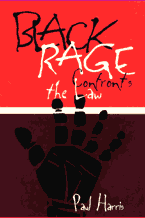
| Archive: Miscellaneous Articles |
page 1 of 1 |
|
In 1971, Paul Harris pioneered the modern version of the "black rage" defense when he successfully defended a young black man charged with armed bank robbery. Dubbed "one of the most novel criminal defenses in history" by Vanity Fair, the black rage defense is enormously controversial, frequently dismissed as irresponsible, nothing less than a harbinger of anarchy. Consider the firestorm of protest that resulted when the defense for Colin Ferguson, the gunman who murdered numerous passengers on a New York commuter train, let on that it was considering a black rage defense. Harris here traces the origins of the black rage defense back through American history, recreating numerous dramatic trials along the way. He recounts in vivid detail how Clarence Darrow introduced the notion of an environmental hardship defense in 1925 while defending a black family who shot into a drunken white mob that has encircled their home. The black rage defense forces us to grapple with questions the criminal justice system simply does not want to hear. Why does a person commit a crime? What is society's responsibility for shaping a nonhabitual offender? If societal factors such as class, poverty, and discrimination do shape us, does this in any way mitigate an explosive, uncharacteristic crime of violence? Emphasizing that the black rage defense must be enlisted responsibly and selectively, Harris skillfully distinguishes between applying an environmental defense and simply blaming society, in the abstract, for individual crimes. Invoking such a defense in the case of Colin Ferguson would have, in Harris' words, sent a "superficial, wrong-headed, blame-everything-on-racism" message. Careful not to succumb to easy generalization, Harris also addresses the possibilities of a "white rage" defense and the more recent phenomenon of "cultural" defenses. He illustrates how a person's environment can, and does, affect his or her life and actions, how even the most rational person can become criminally deranged, when bludgeoned into hopelessness by exploitation, racism, and relentless poverty. Paul Harris worked with the San Francisco Community Law Collective for sixteen years, during which time he was described as one of the best criminal defense lawyers in America. A past president of the National Lawyers Guild, he is Charles Garry Professor of Law at New College’s public-interest law school in San Francisco. Order
this book now from The Center for Guerrilla Law Editorial Reviews: Harris was a partner at a small, radical San Francisco law firm in 1971 when he was encouraged by a community activist to represent a young black accused of bank robbery who had grown up in poverty and was unable to support his family. Arguing that Steven Robinson suffered from what psychiatrists at the time termed a transient situational disturbance, Harris convinced the jury that the defendant "cracked up" because of temporary situational stresses that were the culmination of racial and class oppression. The jury acquitted Robinson, and other lawyers began to use this "black rage" defense. Harris traces the history of this strategy, explaining when, where, and how it can be applied. Obviously useful for criminal defense attorneys, his book at a deeper and more profound level illustrates the degree to which social and economic hardship and deprivation can justify human misconduct. Recommended for public and academic law collections. Phillip
Young Blue, New York State Supreme Court Criminal Branch Lib., New
York
Bonnie Smothers |
||
| |
page 1 of 1 |
|
WELCOME!
You are visitor number |
Designed
by ByteSized Productions © 2003-2006
 Black
Rage Confronts the Law
Black
Rage Confronts the Law